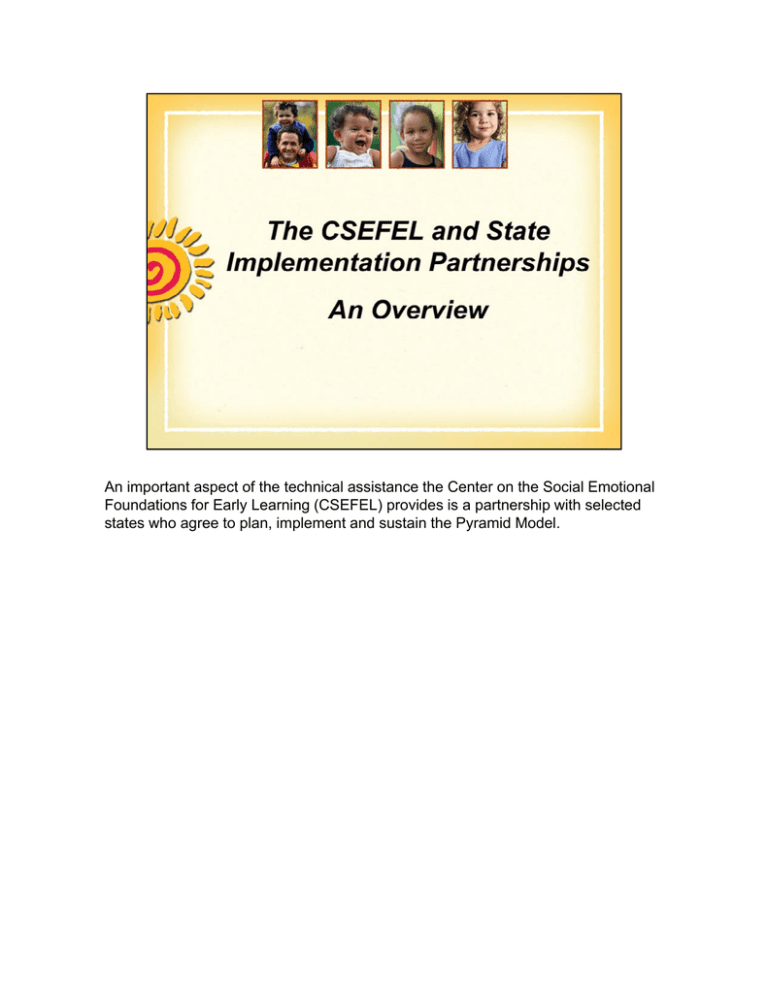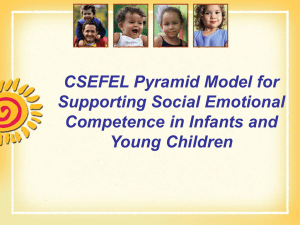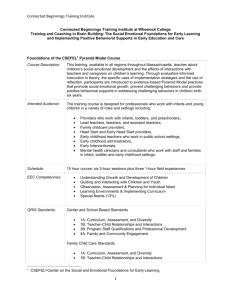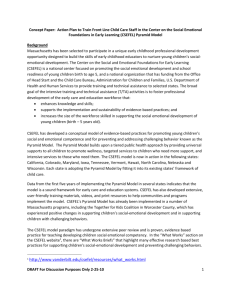An important aspect of the technical assistance the Center on the
advertisement

An important aspect of the technical assistance the Center on the Social Emotional Foundations for Early Learning (CSEFEL) provides is a partnership with selected states who agree to plan, implement and sustain the Pyramid Model. CSEFEL Technical assistance is provided to 3-4 new states a year, over 5 years, to build a professional development system for the early care and education workforce. The over-all goals of the system are to enhance providers’ knowledge and skills, support and sustain the use of effective practices at the local level, and increase the size of the workforce skilled in promoting social emotional development of young children (birth-5 years old). 2 In partnership with CSEFEL, states will accomplish four major goals: 1.They will convene an interagency, collaborative team to develop policies, procedures and other mechanisms to implement, evaluate and sustain the Pyramid Model; 2.They 2 They will train a cadre of trainers and coaches to build the capacity of the workforce and sustain local implementation; 3.They will identify at least three local programs to serve as demonstration sites to illustrate the effectiveness of the Pyramid Model and practices; and 4. They will evaluate outcomes at multiple levels. 3 The technical assistance provided to states by CSEFEL faculty decreases in i t intensity it over three th years. In Phase I, states receive intensive technical assistance from a CSEFEL state facilitator and one or more trainers. Phase 1 work includes the identification and coalescing of a collaborative team, the planning of an infrastructure for sustaining the Pyramid Model, the identification and training of a cadre of trainers and coaches, and the identification of local demonstration sites. In Phase II, states receive technical assistance in developing a plan for monitoring their progress, evaluating their outcomes, sustaining their training, and supporting and mentoring their coaches. And finally, in Phase III, through more limited and primarily distance technical assistance, states sustain their professional development goals and demonstrate the implementation of the Pyramid Model across the state. 4 Phase I: In response to a request for proposals, the states selected for CSEFEL intensive technical assistance commit to engage with the Center in a collaborative effort. Selected states have demonstrated a high level of readiness and commitment to building a professional development system that sustains the Pyramid Model. Each state first identifies a facilitator who will conduct meetings, coordinate the interagency work, be a CSEFEL liaison, and continue the momentum after Phase I. The collaborative, cross cross-system system team engages in state planning through monthly or more frequent meetings, and is charged with planning and overseeing all state CSEFEL activities. After approximately a year of intensive technical assistance, states will have the following in a place: 5 A goal, vision and mission, a written action plan, and strategies to implement and evaluate l t that th t plan. l S Some states t t also l use a logic l i model d l tto d depict i t th their i work k path. th The state planning team will provide the leadership and structure to provide technical assistance, ongoing training, and support to demonstration sites and coaches. States will be able to support intensive training and program development as evidenced by resource and staff allocation. 6 Phase II: During the second phase of state work, CSEFEL provides distance technical assistance through telephone, email, and targeted use of the web. At least one on-site visit is provided to monitor progress, note accomplishments, and address ongoing challenges. During this implementation phase, states will be monitoring and evaluating their progress, planning for sustainability, and mentoring local communities. State-to-state mentoring and peer technical assistance will also begin in phase two. 7 In Phase III, CSEFEL and the state will engage in quarterly individualized checkups to monitor sustainability of the professional development system and problem solve issues that may have arisen. CSEFEL will provide opportunities for states to participate in distance TA involving all partnership states in sustainability initiatives such as: communities of practice, teleconferences, and contributing to the web page specific to state and local capacity building. 8 While we previously discussed sustainability as a Phase II and III activity, planning for sustainability needs to begin early in the planning process! States can’t wait until the end of Phase III to begin the work of sustaining the Pyramid Model, because that is way too late. While funding is important and necessary to sustain certain aspects of the Model, sustainability is not just about money. Different states have diverse opportunities and can leverage the initiatives that compliment the goals of CSEFEL. Some of these initiatives might include new funding for mental health consultants who can act as Pyramid coaches to early care and education programs. A focus on infant mental health training can use the training modules from CSEFEL to train providers working toward a certificate. The state might invest in positive behavior support planning for all children and use the Pyramid model for children birth through five five. 9 What Leads to Sustainability? Research on sustaining new initiatives points to a number of factors that seem to be important. These include: Agreeing on a shared vision Planning authentic collaboration and joint ownership (For example: Having partners answer the question, question “CSEFEL CSEFEL belongs to me because…. because ”)) Having strong leadership and a champion (knowing who will carry on after the Center leaves) Measuring outcomes and effectiveness that demonstrates positive change Using data and stories through marketing to diverse audiences Promoting changes in policies, procedures, and/or legislation, and finally Exploring and identifying new sources of funding 10 What Gets Sustained? In order to fully implement and sustain the Pyramid Model the following key components must be in place: Ongoing training has to be provided regularly to address the high staff turn-over in early care and education. Materials should be readily available to staff as they implement the Model in their own programs. programs Utilizing Demonstration Sites as laboratories for new programs to visit and learn from. Identifying, training, and supervising coaches who support program staff in implementing the Model, and Continuing to evaluate and monitor the fidelity to the Model and the outcomes achieved. achie ed 11 The current states that are receiving intensive technical assistance from CSEFEL include: Maryland, Iowa, Colorado, Vermont, North Carolina, Tennessee, Hawaii, and Nebraska. More are coming this year! 12 While the challenges differ across states, certain commonalities are found. The greatest issue is the time required to fully implement the Model. It takes time to plan the initiative, for staff to be trained and for them to adopt new teaching practices. Finding coaches with the expertise and availability to work in classrooms and homes and to pay for them is a challenge. Learning to use the evaluation tools requires time and expertise and setting up a system for collecting, analyzing and using the data must be addressed. Using these t l to tools t assure fidelity fid lit has h to t be b built b ilt into i t the th evaluation l ti process. States are just now grappling with taking CSEFEL to scale – or state-wide, and we can learn much from their experiences. 13 There are may accomplishments to choose from, including: The CSEFEL training materials are being used across the country and the world. All Head Start staff have been trained on the Pyramid. There is growing interest in the Model from states who have plans for community-wide expansion. Research has shown significant reductions in behavior support referrals and significant increases in confidence displayed by staff Finally, in classrooms where the Pyramid model is being implemented Finally implemented, kids talk the talk and walk the walk! 14 What have we learned? 1. State planning teams are essential to gain broad buy-in of the Model and to share responsibility for sustaining it. 2. It takes lots of time to do this right! 3. It is important to streamline other jobs performed by coaches because they need time to focus on supporting staff to implement the Pyramid to fidelity. 4 Engaging and planning with families is essential to success and continuity 4. continuity. 5. In order for staff to implement the Model there is a need to build in more staff time for collaboration and planning, and finally 6. There is a need to keep this initiative fresh, humorous, and individualized while keeping fidelity to the model. Finally, remember to celebrate successes – both big and small. 15




